 Luigi and me in Kenya in 1991
Luigi and me in Kenya in 1991
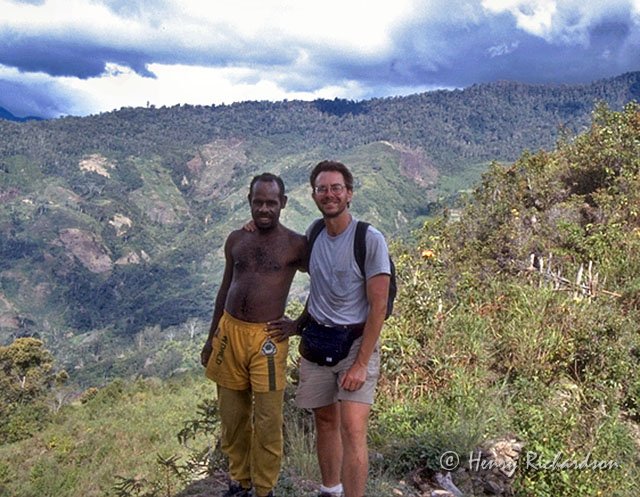 Gupy and me in West Papua, New Guinea in 1995
Gupy and me in West Papua, New Guinea in 1995
West Papua New Guinea Trip Report
For many years I have been traveling around the world and I combine that with the photography I have loved since the late 1960s. In particular, I am a fan of the National Geographic magazine and the old Life magazine style of photography. Sort of street/travel photography with a photojournalistic style or I sometimes call it Life Photography. My interest in photography started in 1968 when I received as a gift a "toy" 120 roll film camera, these days known as the Diana and popular with the art crowd. My recollection is that most of the photos I took with that camera were without film, but I was still fascinated by the idea of photography. Although I lived in Morocco for a couple of years as a small child, my first trip abroad as an adult was in 1985 when I traveled in Japan for a couple of weeks and then a week in Thailand. Those trips sure made a big impression on me and really taught me how much travel was going to be an important part of my life. The trip to Japan turned out to strengthen a life-long interest in the country and people and led me later to live there for several years. Since those trips I have traveled in dozens of countries, several of them multiple times, on five continents all over the globe, experienced many large and small kindnesses, dealt with many mishaps and misunderstandings, and met many wonderful (and not so wonderful) people. Photography is always an important part of my travels, but it is not the only thing. Seeing, doing, meeting are just as important. I believe the photography, rather than getting in the way of these things, has enhanced my ability to do them and they sort of create a sympathetic resonance that give each other more energy.
 Luigi and me in Kenya in 1991
Luigi and me in Kenya in 1991
I have been fortunate to not have many mishaps involving injury or illness while traveling. Well, there was one incident. I was working in Tokyo and decided I really wanted to visit Kenya. I bought a round-trip plane ticket to Nairobi with no plans other than to spend three weeks there and see what I could see. It was a long flight though because the Pakistan Airlines plane made stops in Manila, Bangkok, Karachi, and Abu Dhabi before finally arriving in Nairobi. No plane transfers, just stops of 1.5 to 4 hours in each place. The long flight of about 28 hours did give me time to get to know the two young Japanese women sitting next to me though. They were on a 5-day trip to Kenya and Egypt -- 5 days including travel time to and from Tokyo. They would have a bit over one day in each of Kenya and Egypt and, of course, travel time from Nairobi to Cairo. Anyway, back to the mishap. Awhile after arriving in Kenya I met an Italian guy named Luigi traveling on his own and two German guys named Rainer and Friedhelm traveling together. We were all about the same age and got along well so we decided to rent a 4WD vehicle together for about ten days and travel up to the northern part of Kenya and also climb Mt. Kenya. Mt. Kenya was first on our agenda so after a couple of days of preparation and hiring a guide in the small town of Chogoria we set off. The weather started out pretty good, but when we were coming back down the mountain it started raining cats and dogs. At one point when we were scrambling down a slope of boulders and big rocks my foot slipped on one, twisted, and went down in the crevice between two of them. Quite a lot of pain, but I pulled my foot out and continued down the mountain -- now with a severe limp and shooting pain at each step though. There were park rangers and some huts where we had left the 4WD so since it was dark by this time we were able to spend the night in one of the huts. When we finally got inside where it was dry and there was some light I took my hiking boot off my foot to discover that it was almost completely black and purple. Within a couple of hours it had swollen to almost twice it's normal size. Hmm, I think this sucker is broken, I thought to myself. My mother had always said I was a bright kid. Nothing to be done about it tonight, but the next morning one of the park rangers came around and looked at it. He was a bright guy too. He said it looks broken. He went and cut me a walking stick and I slowly and painfully pushed my foot into my bootlace loosened boot and then carefully tightened the laces. I felt embarrassed because I was wondering what Luigi, Rainer, and Friedhelm were thinking about how this might affect the rest of their trip. No one likes to be a burden on someone else, especially people you have only recently met. I assured them I was okay so let's just continue as before. We did. For the next week we continued traveling around northern Kenya and finally made it back to Nairobi. That walking stick was a lifesaver since I did lots of walking and I wished that I could have taken it back to Japan with me for sentimental sake but, sadly, I had to leave it behind. The day after returning home I went to a hospital in Tokyo. By now the swelling had gone down a lot and there wasn't so much black and purple. The doctor took an x-ray and returned shaking his head. "Did you know your foot is broken? When did this happen?", he asked me. I told him that it was two weeks ago in Kenya. It turns out that one of the larger bones was broken and rather than the jagged ends that he would expect to see at the break instead both ends were completely smooth. That is what happens when you walk on it for two weeks. It all ended up fine. I had a cast on my foot almost to my knee for five weeks and then I just just could not stand it anymore so he took it off, three weeks earlier than he intended.
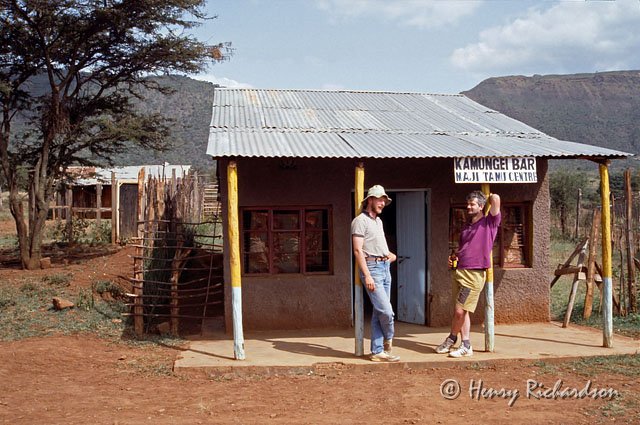 Rainer and Friedhelm at the Kamungei Bar, countryside in northern Kenya
Rainer and Friedhelm at the Kamungei Bar, countryside in northern Kenya
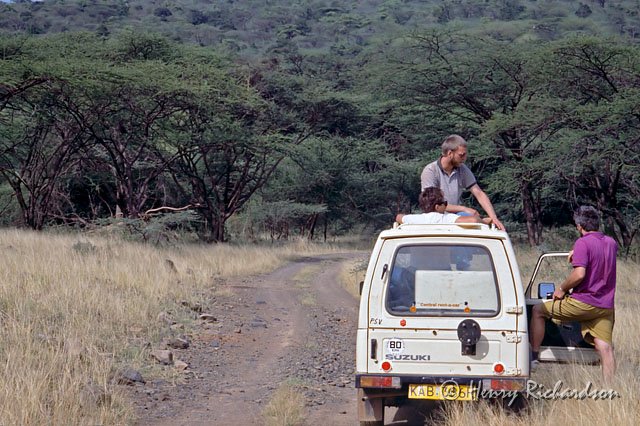 Rainer, Friedhelm and Luigi in our 4WD in northern Kenya
Rainer, Friedhelm and Luigi in our 4WD in northern Kenya
When I am traveling I often walk alone for hours and hours a day with my eyes peeled and camera ready. With this kind of photography one usually has little control over light, background, and subject position. Often as you are walking you see someone and it all happens very quickly with little time to think or frame. You just do your best. Sometimes fortune smiles on you and brings it all together though. A lot truly is serendipity. Sometimes I also find a good place to just sit and wait for the world to pass by and that also can yield good photos. I tend to be too restless to do that for long though, but while I am sitting outside with a cold drink on a hot day it is a good chance to blend into the background (well, as much as a white American can blend into places such as Egypt, Cambodia, Japan, etc.) to watch and photograph.
There is no "correct" way of taking photos of people you do not know while on "the street." Each photographer must find what feels right and natural for themselves. For example, some only take photos of people who they have asked and received permission to photograph. I do that too sometimes, but often the subject is posing or since the subject is aware of the camera they are not behaving in a natural way. Still, those kinds of photos can be wonderful too and I also take them! Many of my photos are of people who are not aware of the camera though, although some become aware right at the moment of exposure or immediately afterwards. It is amazing how often people seem to have a sixth sense that tells them someone is looking at them! :-) If the subject sees me taking the photo then I smile in a disarming way and thank them. Although some people become angry if they are photographed most do not care and there are others who are so happy to be photographed that they will actively try to get me to take their photograph. Sometimes it is hard and then sometimes it is so easy! Also, there is no "right" camera or lens for this type of photography, despite what internet yahoos will try to tell you. The world is full of self-appointed "experts" who will insist you do things their way and if you don't then you are an idiot. Ignore them. Usually if you dig a centimeter deep you will discover they are obsessive, neurotic gearheads who never or rarely take photos themselves.
My philosophy with regards to photos is that you should do what you like and, if you want, you can show them to people. If they like them then fine, but it usually isn't a good idea to suppress or change your own sense and adopt what other people think about your photos. Do that and you will be changing all the time going this way and that because people will have various and differing opinions. Trust yourself. If no one is paying you to take photos then why bother with trying to please other people? You'll end up chasing your tail. Believe in your own work. To thine ownself be true.
I usually backpack travel close to the ground, use local transport, and stay at guesthouses, small hotels, and hostels. Years ago I would sometimes carry a small tripod with me when I traveled, but for my type of photography I rarely used it so it was just a nuisance. Then I started using a monopod and that was much more useful, especially in the evenings. For the last few years though I don't even carry a monopod. I have image stabilization now and that is usually sufficient, even in the evenings. The image stabilization along with the wonderful high ISO performance of DSLRs (in comparison to high ISO film a few years ago) means I don't miss the monopod. Here is my medium-size travel backpack that I have been using for the last few years. It holds all my camera gear and everything else too (also there is an empty daypack inside to use when I am walking around that I use to hold camera gear, water, etc.):
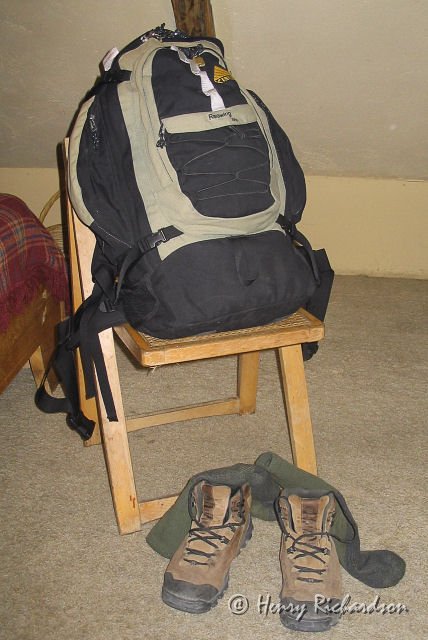 My backpack in a little hotel in Quito, Ecuador
My backpack in a little hotel in Quito, Ecuador
It is very useful to think about what kinds of photos generally stand the test of time. Usually photos of landscapes, scenics, flowers, birds, pets, and so on after a short time are mostly forgotten and no one cares about them anymore because every Tom, Dick, and Harry is constantly taking more of those and they are often almost identical. Photos of people, people in their environment, street photos, etc. though, even many years later, often are very interesting and admired. I recognized this decades ago so maybe that is why I am more interested in that type of photography. Yes, I also take landscape and other sorts of photos too, but they are not my primary interest.
I like to photograph people going about their lives in a natural way and more or less unaware of the camera. I hope these photos are a tiny vignette, a slice of time, a captured moment of their life. Because the subject is often unaware they are being photographed I feel I have some responsibility to not intentionally capture them in particularly embarrassing or awkward moments. I balance that though with the belief that in the future when people look at my photos -- if they do! -- then the documentary value of them will greatly override any minor concerns about whether the subject might feel slightly embarrassed. The truth is that I pass on many wonderful photo opportunities because I am not bold enough. Even if the subject is not aware of the camera sometimes other people in the area are so I am always cognizant of that and sometimes pass on a photo because of it. I then continue walking along kicking myself in the behind lamenting the loss of a wonderful photo, but in the end, it is only a photo and another opportunity is probably just around the next corner. It is harder than many people realize to photograph strangers, often at close range.
There are many styles of travel, but my preferred style is what I call close-to-the-ground travel with just a medium-size backpack. It also means that I often only buy a plane ticket to my destination and I do not have an itinerary planned out beforehand. I do not have hotel reservations made in advance so I usually stay at guesthouses, small hotels, and hostels that I find along the way. A Lonely Planet book (or equivalent) does come in very handy though! Although some of my trips have lasted several months, most of the time they are about a month long. The backpack, close-to-the-ground travel style, and the length of time all mean that I must be very careful about the size and weight of my camera gear and what makes the cut to go with me.
 Me, Kerry, Nigel, and friends on the River Kwai in 1998
Me, Kerry, Nigel, and friends on the River Kwai in 1998
On the famous (infamous?) River Kwai near Kanchanaburi I, along with Kerry and Nigel, two New Zealanders that I was traveling with in Thailand, were paddling kayaks down the river as the sun was going down. A big motorized pontoon boat was approaching us from the rear with a large group of young Thais having a party. As it got closer we saw that a whole bunch of beautiful young women were standing at the railing looking at us, smiling, laughing, and motioning for us to get closer. Kerry, Nigel, and I did not need much encouragement so we paddled mightily to get alongside the boat before it passed. We grabbed the ropes hanging from the side so that we were then being pulled along flush up against the starboard side while the excited girls (the guys were decidedly less excited) knelt down at the railing and enthusiastically tried to talk with us, give us food, and hold our hands. After a few minutes an older man came over and gestured in such a way that left little doubt as to his meaning so we let go of the ropes and sadly waved goodbye to all those pretty Thai girls. As we watched the boat getting farther and farther away I sighed and said, "Boys, you know what that is, don't you? That is one of those golden opportunities that only appear rarely in life and we just let it slip away." :-)
In my opinion, a whole lot of people get way too obsessed about technical image quality (extreme sharpness, minimal distortion, minimal chromatic aberration, noise, etc.) and almost totally ignore making quality images. Personally, I also chuckle when I hear someone repeat the old saw about it being "all about the glass" or "all about the lenses." Spend time looking at photos over the past 50-100 years. Notice how many of those that are so wonderful are wonderful almost always because of subject, composition, timing, lighting, etc. and almost never because of the particular lens and whether it was marginally sharper, had slightly less distortion, and so on than another lens. Let the gearheads who do not actually take many photos worry themselves to death about that stuff. Take photos and you will get better. Obsess over gear and you will just end up being a gear fanatic. :-) You just can't buy your way to good photos, but getting out there with the gear you have and taking photos, looking at other people's photos, and thinking will improve your vision and skills so that you can start taking good photos.

I do understand the attraction of quality gear, the aesthetics, the tactile feel, the perceived status conferred, and so on though. I just also understand that a lot of people get sidetracked in their hope to take photos they really like by getting on the gear track. Also, there are people who love cameras and gear as a hobby and are not all that interested in photography. Nothing wrong with that. It's your money and you can do with it what you want -- after you have paid all of your taxes to various government entities that demand the first cut, that is. :-) All just my opinion, of course.
"I'm always amused by the idea that certain people have about technique, which translate into an immoderate taste for the sharpness of the image. It is a passion for detail, for perfection, or do they hope to get closer to reality with this trompe I’oeil? They are, by the way, as far away from the real issues as other generations of photographers were when they obscured their subject in soft-focus effects." -- Henri Cartier-Bresson
Years ago I wrote about IQ vs. QI:
IQ = Image Quality (strictly on the technical aspects of the sensor, etc. -- noise, noise reduction artifacts, sharpness, and so on) and it should not be confused with the much more important QI = Quality Image. To have high QI you need to be a good photographer.
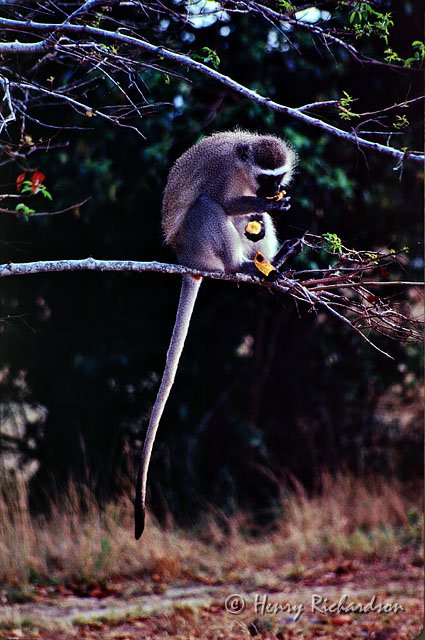 Monkey with my banana in Zimbabwe
Monkey with my banana in Zimbabwe
Africa is such a cool place to visit! In 1993 I went on a 10-week Africa camping safari starting in Capetown, going through South Africa, Namibia, Botswana, Zimbabwe, Zambia, Malawi, Tanzania, Kenya, and then ending in Nairobi. I had also spent several weeks in Kenya a few years before when I broke my foot. One morning after awakening outside the Great Zimbabwe ruins where we were camped I stumbled my way to the campfire for coffee and some breakfast. I had my camera hanging off my shoulder, a cup of hot coffee and a banana in one hand, and a plate of breakfast in the other hand. It was pretty early in the morning and I was walking from the campfire to a camp stool under a big tree. I carefully put my plate down on the camp stool, took the banana out of the hand with the coffee, placed it on the ground next to the stool, and then straightened up in preparation to pick up the plate and sit and chow down. A second or so had elapsed since my hand had left the banana at my feet and suddenly there was a specter-like gray blur and sensation of something rushing between my legs. I was certainly startled, but quickly turned and saw the monkey who had jumped off the tree, grabbed my banana, and was running away! I dropped the coffee and ran after him with my camera. I guess I ran over 100 meters across a field with the monkey bandit way out in front of me until he jumped up on a small limb, settled down, and started eating my banana. I got closer and took this photo. As I walked back to my breakfast I felt it was a good trade. When I got back to camp everyone was laughing and asking me if I really thought I was going to get my banana back. :-) I thought they knew me better than that. I was after a photo of the monkey with my banana and I got that. :-)
A traveler is daily, sometimes hourly, and sometimes even more often presented with unexpected situations, people, sights, sounds, and smells. These make traveling rarely boring, keep you on your toes, challenges your self-reliance and problem solving skills, and also keep one's photographic juices flowing. I can speak only for myself, but I derive much more pleasure from spending money on these things than more objects and more possessions.
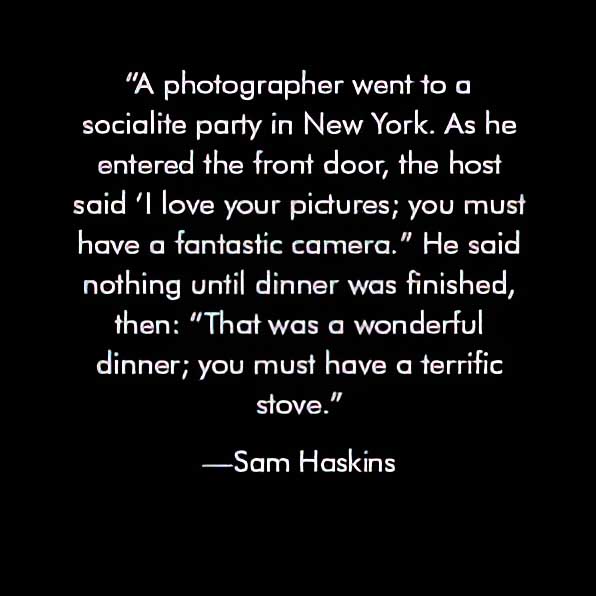
That's a good one. I have seen variations on it. For example, complimenting a novelist and saying they must have a very good pencil/typewriter/word processing program. :-) Or to a musician and saying they must have an excellent violin, piano, guitar, etc. :-) Or to a hairdresser saying they must have great scissors. :-)
Copyright Henry Richardson